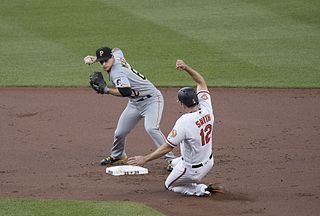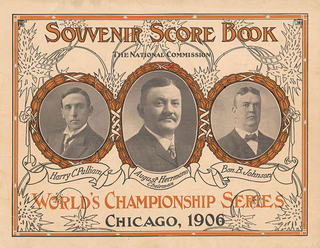This article needs additional citations for verification .(July 2013) |

In baseball, a run is scored when a player advances around first, second and third base and returns safely to home plate, touching the bases in that order, before three outs are recorded and all obligations to reach base safely on batted balls are met or assured. A player may score by hitting a home run or by any combination of plays that puts him safely "on base" (that is, on first, second, or third) as a runner and subsequently brings him home. Once a player has scored a run, they may not attempt to score another run until their next turn to bat. The object of the game is for a team to score more runs than its opponent.
Contents
- Examples
- Significant run scoring records
- Player
- Team
- Postseason
- World Series
- See also
- References
- External links
The Official Baseball Rules hold that if the third out of an inning is a force out of a runner advancing to any base then, even if another baserunner crosses home plate before that force out is made, his run does not count. However, if the third out is not a force out, but a tag out, then if that other baserunner crosses home plate before that tag out is made, his run will count. In baseball statistics, a player who advances around all the bases to score is credited with a run (R), sometimes referred to as a "run scored". While runs scored is considered an important individual batting statistic, it is regarded as less significant than runs batted in (RBIs). Both individual runs scored and runs batted in are heavily context-dependent; however, the sabermetric statistic runs created provides a more sophisticated assessment of a player's contribution toward producing runs for his team.
A pitcher is likewise assessed on runs surrendered in his statistics, which differentiate between standard earned runs (for which the pitcher is statistically assigned full responsibility) and unearned runs scored due to fielding errors, which do not count in his personal statistics. Specifically, if a fielding error occurs which affects the number of runs scored in an inning, the Official Scorer – the official in-game statistician – in order to determine how many of the runs should be classified as earned, will reconstruct the inning as if the error had not occurred. For example, with two outs, suppose a runner reaches base because of a fielding error, and then the next batter hits a two-run home run, and then the following batter then makes the third out, ending the inning. If the inning is reconstructed without the error, and if that third batter, instead of reaching on an error, registered an out, the inning would have ended there without any runs scoring. Thus, the two runs that did score will be classified as unearned, and will not count in the pitcher's personal statistics. [1]
If a pitching substitution occurs while a runner is on base, and that runner eventually scores a run, the pitcher who allowed the player to get on base is charged with the run even though he was no longer pitching when the run scored.









